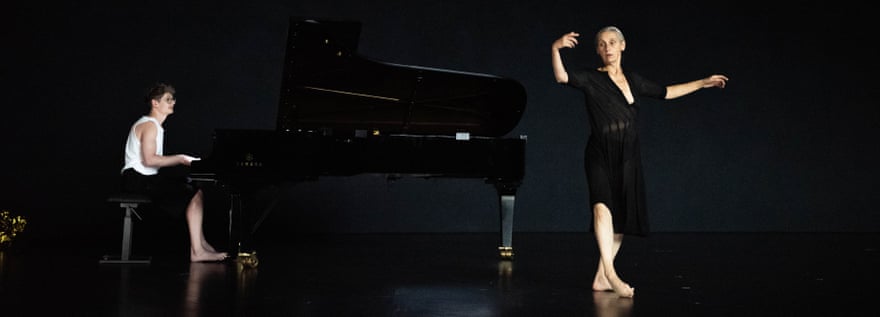Anne Teresa de Keersmaeker is not someone you expect to see dancing in silver sequined hotpants: a high queen of choreographic seriousness and an austere presence on stage. This solo is both a departure from and a distillation of what we know of the Belgian choreographer. Her 42 years of work has spanned starkly formal early pieces, shimmering group dances and sober solos, all wedded to the details of musical structures.
In this case the music is Bach’s late masterpiece The Goldberg Variations, and it’s not really a solo, because her stage is shared with pianist Pavel Kolesnikov. In white vest, black shorts and bare feet, he sits with his back to the audience – he’s playing for her, not us – introducing the music’s theme with divine delicacy. Kolesnikov’s playing dances and sings as De Keersmaeker provides some profound listening experiences, standing still to let Bach breathe, even cutting the lights in mournful variation 25 to cocoon us in sound.
You wouldn’t blame De Keersmaeker for also needing a breather. Over the course of two hours she is almost constantly moving, casting her body in different lights: in sheer dark dress for the most composed, focused, precise material (looking little different from her younger self); later in champagne-coloured trouser suit she throws in some punky swagger, before stripping to hot pants and pink shirt – only this final section hints at the vulnerability of the flesh.
At first, you can see the choreographic material of De Keersmaeker’s theme returning in variations, designed with rigour and quotations from her own canon. Then it spins out in tangents, endless extrapolating, until she’s hanging underneath the piano, literally partnering it. She’s an opaque presence, eyes mostly down on the floor or watching her limbs, po-faced even when making comical shapes. It’s somehow intimate while giving us little of herself.
By the time the theme returns we have been on a journey of riches and strangeness, indulgence, frustration and beautiful music. There’s something incredible about witnessing De Keersmaeker’s steadfast commitment to her craft, her mining of musical form (and her undimmed abilities) but there’s not much in the way of connection or joy.

